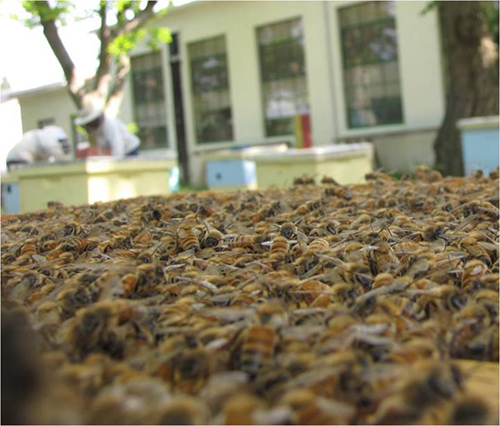The agriculture importance of the honey bee cannot be overstated and in recent years declines in bee populations has become troubling, leaving scientists scrambling to understand the intricacies that encapsulate this essential insect. To that end, scientists from Penn State University and Georgia Institute of Technology have found that honey bees use collections of genes, from two distinctly separate mechanisms, to ward off viruses, bacteria, and gut parasites.
“Our results indicate that different sets of genes are used in immune responses to viruses versus other pathogens, and these antiviral genes are regulated by two very distinct processes—expression and DNA methylation,” explained David Galbraith, graduate student in entomology at Penn State University and lead author on the study.
The findings from this study were published recently in PLoS Pathogens through an article entitled “Parallel Epigenomic and Transcriptomic Responses to Viral Infection in Honey Bees (Apis mellifera).”
“Honey bees have more than 20 types of viruses, and several of them have been linked to losses of honey bee colonies,” said Christina Grozinger, Ph.D., director of the Penn State Center for Pollinator Research and senior author of the current study. “Yet, beekeepers currently do not have any commercially available methods to reduce viral infections.” Consequently, Dr. Grozinger noted that beekeepers lose 30% of their colonies on average every winter and 25% in the summer.
Dr. Grozinger and her team looked at several different pathways they felt could aid the bees’ immune system in combating viral attacks. Analyzing previous findings from Drosophila they surmised that RNAi pathways, which play a major role in the fruit fly survival rate and overall health, might be a significant part of the honey bee antiviral defense mechanism.
“Previous studies suggested the RNAi pathway was involved in antiviral immune responses in bees, but we showed that expression levels of many genes in this pathway are significantly higher in virus-infected bees,” stated Dr. Grozinger. “The RNAi pathway helps to cut up and destroy viral RNA so it is not infectious.”
In addition to examining gene expression in virus-infected versus uninfected honey bees, the investigators also scanned the honey bee DNA for further methylation marks that may have been added or removed from genes in virus-infected bees.
Dr. Grozinger’s team found that viral infections in honey bees dramatically changes their methylation pattern, and in a distinctly different set of genes from those in the RNAi pathway. Moreover, many of these infection induced methylated genes are homologous to antiviral genes found in mammals—however they have not been previously linked to antiviral responses in insects.
“We found that there was very little overlap between differentially expressed and differentially methylated genes, suggesting dual genomic response pathways to viral infection,” explained Galbraith. “For the first time, we characterized both the global gene expression and DNA methylation patterns associated with acute viral infection in honey bees. We confirmed that the RNAi pathway, which has been seen in other insects, is also an antiviral defense mechanism in honey bees. And, for the first time, we observed alterations in DNA methylation patterns in response to viral infection in honey bees.”



